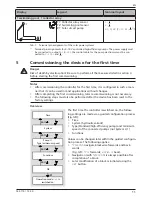
9
742.110 | 14.50
EN
4.3.2
Preparing the cable openings
The cables can be fed through openings in the rear wall of the casing or at the bottom
of the casing. The openings are pre-punched and must be prepared as required before
installation.
Prepare the cable openings in the rear wall of the casing as follows:
1. Break out the cable openings
(Fig. 3) using a suitable tool.
2. Deburr the edges.
Prepare the cable openings at the bottom of the casing as follows:
1. Cut the
required
cable openings
(Fig. 3) at the left and right using a suitable knife
and break them out.
2. Deburr the edges.
4.3.3
Connecting the cables
√
All cables are voltage-free.
√
The cable openings have been prepared.
X
Observe the following points when connecting the cables:
•
Connect the cable conductors to the correct terminals as described in sec-
tion 4.4, p. 10.
•
Mains input and output: First connect
PE
, then
N
and
L
.
•
Strain relief:
– First clamp the
lower
strain relief clamps and then the
upper
strain relief
clamps.
– When using the
upper
strain relief clamps, use the plastic links as described
below.
– If the opening in the strain relief clamp is too large, e.g. in the case of thin ca-
bles, turn over the strain relief clamping bar (with the bend facing down). Only
use the strain relief clamps for cables entering the bottom of the casing. Use
external strain relief clamps when feeding cables through the rear of the casing.
4.3.4
Inserting/Removing plastic links
Insert the plastic links as follows:
1. Insert the right plastic strip with the latching protrusion first
(Fig. 4).
2. Press the other side of the plastic strip down
, until the spring clamp latches into
place.
3. Insert the left plastic strip the other way around (latching protrusion to the left,
spring clamp to the right).
Fig. 4: Inserting the right plastic link
Summary of Contents for TR-A501T-U
Page 47: ...47 742 110 14 50 EN 18 Notes ...
Page 48: ...48 742 110 14 50 EN 742110 ...










































